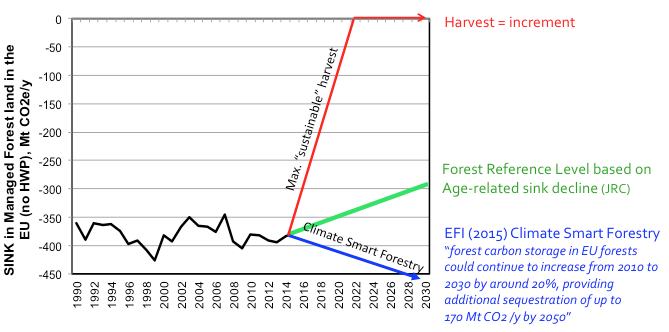
Guest post: How new EU rules could ‘hide’ climate impact of harvesting forests
Multiple Authors
06.19.17Multiple Authors
19.06.2017 | 5:08pmThis is a guest post by Dr Jo House, co-chair of the Global Environmental Change Theme at University of Bristol’s Cabot Institute and Dr Hannes Böttcher, Senior Researcher at Oeko-Institut, Berlin.
Today, the EU began drafting laws to put its 2030 climate target into action – and there is one particularly contentious issue under discussion.
In the EU, forests act as a “carbon sink”, which means that they absorb more CO2 than they release. But new policies being proposed could result in more trees being harvested. What’s more, some countries are arguing for new accounting rules that would effectively hide the impact these policies could have for raising CO2 emissions from forests.
We are among the 40 scientific experts to sign a joint letter proposing a more scientifically-objective way to account for the climate impact of harvesting forests.
The signatories are calling on the EU to set a “gold standard” for emissions accounting, which is needed if the forest and land use sector is to comply with a 2C pathway and the spirit of Paris Agreement.
Forest sinks
Land carbon accounting is complex. It is different from other sectors since land is simultaneously a source and a sink of CO2. It can be hard to disentangle natural exchanges of CO2 between the land and atmosphere from those that are due to human activity. There are also “legacy effects”, which means that cutting or planting trees many years in the past (before global agreements on climate change) still have effects into the future.
Deforestation is responsible for almost one tenth of human-caused CO2 emissions. In the EU, however, forests currently grow more than they are harvested. This means they, on balance, act as a ”carbon sink”. Overall, they remove more than 400 million tonnes of CO2 from the atmosphere each year – equivalent to 10% of total EU greenhouse gas emissions.
Reducing deforestation, planting new forests and increasing the use of bioenergy are critical to limiting warming to “well below 2C” – the ambitious goal laid out in the Paris Agreement. Indeed, countries expect forests to meet about a quarter of their pledged emissions reductions, as we explained in a Carbon Brief guest post earlier this year.
The problem is that the way forest emissions are included international climate agreements is complex, and can result in estimates of mitigation in 2030 ranging from 1.9 to 3.8 billion tonnes of CO2 equivalent per year (GtCO2e/y).
The problem with forest accounting
Under the second commitment period of the Kyoto Protocol, countries began accounting for the impacts of managed forests on the atmosphere by comparing them to a baseline, known as the ‘Forest Reference Level’.
A scientifically robust baseline, as initially proposed by the European Commission, should take into account historical data on forest management activities and forest dynamics (age-related changes). If countries change forest management activities in future, the impact would be calculated based on changes in emissions and sinks relative to that baseline.
But it’s worth noting at this point that the net “carbon sink” from EU forests is due to afforestation and forest restoration that mostly took place over 30 years ago. And as these forests mature, this net sink is expected to decline.
So, while the EU forest sink is currently 400MtCO2e/y, a more up to date and scientifically-robust baseline would see that sink drop to around 300 MtCO2e/y by 2030, as the green line in the graph below shows. Any impact of policy change, such as an increase in harvesting, should then be compared to this baseline.

EU net carbon sink in managed forest land, historical and future scenarios. Elaboration of a slide by the Joint Research Centre of the European Commission.
Some EU Member States have proposed that any increase in harvesting up to the level of the net sink should not be penalised because it counts as “sustainable” forestry (ie. harvest = growth). The suggestion from them is that this increase in harvesting, and related changes in the net carbon sink, should be included in the baseline. This would effectively become a zero net sink.
Put simply, this suggestion could effectively hide emissions reductions of up to 300 MtCO2/yr, compared to a more scientific baseline. For context, this is equivalent to about two thirds of France’s annual emissions.
Of course it is not quite that simple.
Accounting for harvesting
The introduction of a baseline for forest carbon accounting between the first and second commitment period of the Kyoto Protocol had meant that some countries were disadvantaged.
The new suggestion from the EU Presidency of Malta proposes that countries would not be penalised for harvesting up to a threshold of 80% of the forest sink each year. After this threshold, they could still harvest but the effects would be have to be accounted.
But some member states have asked to increase the harvest threshold to 100%. While this could be sustainable, in the sense that there would be no net forest emissions, it reduces the forest sink beyond what would have happened without that policy. This leads to an increase in CO2 concentrations in the atmosphere, which is effectively the same as an increase in emissions. A review of these different approaches found that between 53 and 376 Mt CO2/year could potentially be left unaccounted.
The wood that is harvested from forests can go towards reducing emissions in other sectors if, for example, it is used in place of other more emissions-intensive materials, such as cement or fossil energy.
This is a great way for forests that are approaching maturity to continue contributing to mitigation. A recent study found forest management could increase EU sinks by about 170 MtCO2e/y by 2030, for example, while also contributing to materials and energy substitution.
Lowering emissions by using wood instead of more carbon-intensive materials will be implicitly be counted in these other sectors. So, in order to avoid incomplete accounting, the impact of increased harvesting should be similarly accounted for in the land use sector.
The overall effect of using more wood for substitution, reducing the forest sink, may still be a net decrease in atmospheric concentrations. But by fully accounting in all sectors, the impact of policies on the atmosphere will be more accurately represented.

Young forest with planted pines (Pinus sylvestris), Västerbotten, Sweden. Credit: age fotostock / Alamy Stock Photo.
‘Gold standard’
Current guidance from the Intergovernmental Panel on Climate Change (IPCC) – the United Nations body that assesses the evidence on climate change – follows just this approach.
It says that emissions from bioenergy should not be assumed to be carbon neutral, but rather that any carbon losses should be reported under the ‘Land Use, Land-Use Change and Forestry’ (LULUCF) sector. Similarly, EU legislation on bioenergy relies on the assumption that carbon emissions are fully accounted for in the LULUCF sector.
The Paris Agreement states that countries should “take action to conserve and enhance sinks” and ensure transparency. This should mean taking account of the full impacts of policies on forest emissions and sinks, providing balanced accounting across all greenhouse gas sectors, and incentivising as far as possible the best outcome for the atmosphere.
Incomplete accounting for the impact of policies on sources and sinks could lead to perverse incentives to reduce sinks, which will make it harder to reach the temperature targets laid out in the Paris Agreement. Staying on an emissions pathway consistent with 2C would then require bigger emission reductions in other sectors.
The EU can set the gold standard for forest carbon accounting that other countries can follow. Failing to do so risks setting a precedent for other countries with even larger forest carbon sinks, undermining what hope we have of achieving the Paris Agreement goals.
Final decision pending
In the negotiations today, several countries emphasised the need for a scientifically credible approach and for EU leadership. Italy commented that “honest accounting rules” that are “based on data and parameters, not political positions” were needed, while Belgium suggested the Malta presidency proposal would “weaken environmental integrity”.
Around 10 member states supported the original European commission proposal based on historic management, while 10 said they wish to include future policy in the baseline. The positions of other countries was less clear. Due to the polarisation, a final decision will probably now be put off until October, giving more time to make clear the complex science issues.
We suggest that basing forest accounting on a scientifically-objective approach, such as the one originally proposed by the European Commission, is critical to ensure the credibility of bioenergy accounting, consistency between EU targets and a 2C trajectory, and compliance with the spirit of Paris Agreement.
-
Guest post: How new EU rules could ‘hide’ climate impact of harvesting forests

